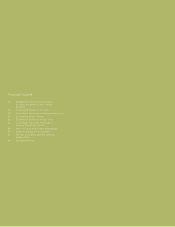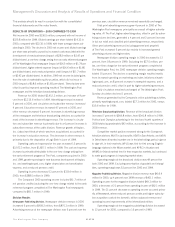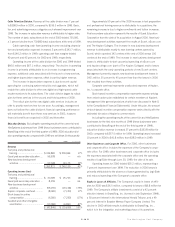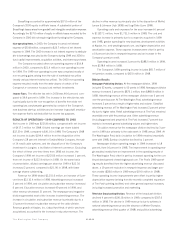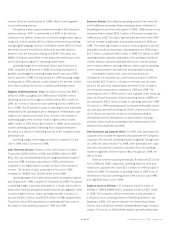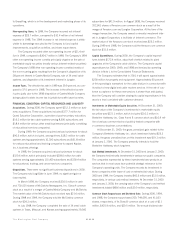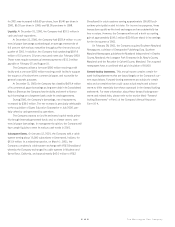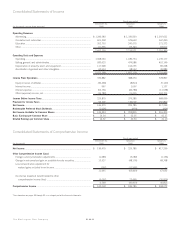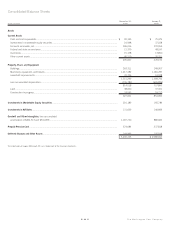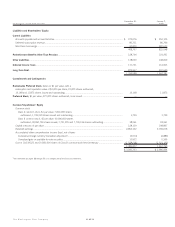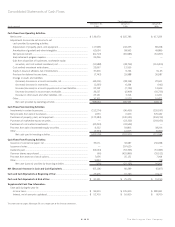Washington Post 2000 Annual Report Download - page 2
Download and view the complete annual report
Please find page 2 of the 2000 Washington Post annual report below. You can navigate through the pages in the report by either clicking on the pages listed below, or by using the keyword search tool below to find specific information within the annual report.
The Washington Post Company
Management’s Discussion and Analysis of Results of Operations and Financial Condition
27
This analysis should be read in conjunction with the consolidated
financial statements and the notes thereto.
RESULTS OF OPERATIONS—2000 COMPARED TO 1999
Net income for 2000 was $136.5 million, compared with net income of
$225.8 million for 1999. Diluted earnings per share totaled $14.32 in
2000, compared with $22.30 in 1999, with fewer average shares out-
standing in 2000. The decline in 2000 net income and diluted earnings
per share was primarily caused by increased costs associated with the
development of new businesses (impact of $28.9 million or $3.47 per
diluted share), a one-time charge arising from an early retirement program
at The Washington Post newspaper (impact of $16.5 million or $1.74 per
diluted share), higher interest expense (impact of $16.6 million or $1.85
per diluted share), and a reduced pension credit (impact of $11.7 million
or $0.92 per diluted share). In addition, 1999 net income included gains
from the sale of marketable equity securities, which did not recur in
2000 (impact of $18.6 million or $1.81 per share). These factors were
offset in part by improved operating results at The Washington Post
newspaper and the television broadcasting division.
Revenue for 2000 totaled $2,412.2 million, an increase of 9 per-
cent from $2,215.6 million in 1999. Advertising revenue increased
5 percent in 2000, and circulation and subscriber revenue increased
4 percent. Education revenue increased 47 percent in 2000, and
other revenue decreased 6 percent. Increases in advertising revenue
at the newspaper and television broadcasting divisions accounted for
most of the increase in advertising revenue. The increase in circula-
tion and subscriber revenue is primarily due to a 6 percent increase in
subscriber revenue at the cable division. Revenue growth at Kaplan,
Inc. (about two-thirds of which was from acquisitions) accounted for
the increase in education revenue. The decrease in other revenue is
primarily due to the disposition of Legi-Slate in June of 1999.
Operating costs and expenses for the year increased 13 percent to
$2,072.3 million, from $1,827.1 million in 1999. The cost and expense
increase is primarily attributable to the one-time charge arising from
the early retirement program at The Post, companies acquired in 2000
and 1999, greater spending for new business development at Kaplan,
Inc. and washingtonpost.com, higher depreciation and amortization
expense, and a reduced pension credit.
Operating income decreased 13 percent to $339.9 million in
2000, from $388.5 million in 1999.
The Company’s 2000 operating income includes $61.7 million of
net pension credits (excluding the one-time charge related to the early
retirement program completed at The Washington Post newspaper),
compared to $81.7 million in 1999.
Division Results
Newspaper Publishing Division. Newspaper division revenue in 2000
increased 5 percent to $918.2 million, from $875.1 million in 1999.
Advertising revenue at the newspaper division rose 5 percent over the
previous year; circulation revenue remained essentially unchanged.
Total print advertising revenue grew 4 percent in 2000 at The
Washington Post newspaper, principally as a result of higher advertis-
ing rates. At The Post, higher advertising rates, offset in part by adver-
tising volume declines, generated a 4 percent and 2 percent increase
in full run retail and classified print advertising revenue, respectively.
Other print advertising revenue (including general and preprint)
at The Post increased 5 percent due mainly to increased general
advertising volume and higher rates.
Newspaper division operating margin in 2000 decreased to 12
percent, from 18 percent in 1999. Excluding the $27.5 million, pre-
tax, one-time charge for the early retirement program completed at
The Washington Post, the 2000 newspaper division operating margin
totaled 15 percent. The decline in operating margin resulted mostly
from increased spending on marketing and sales initiatives at wash-
ingtonpost.com, an 8 percent increase in newsprint expense, and a
reduced pension credit, offset in part by higher advertising revenues.
Daily circulation remained unchanged at The Washington Post;
Sunday circulation declined 1 percent.
Revenue generated by the Company’s online publishing activities,
primarily washingtonpost.com, totaled $27.1 million for 2000, versus
$15.6 million for 1999.
Television Broadcasting Division. Revenue at the broadcast division
increased 7 percent to $364.8 million, from $341.8 million in 1999.
Political and Olympics advertising in the third and fourth quarters of
2000 totaled approximately $42 million, accounting for the increase in
2000 revenue.
Competitive market position remained strong for the Company’s
television stations. WJXT in Jacksonville, KSAT in San Antonio, and WDIV
in Detroit were all ranked number one in the latest ratings period, sign-on
to sign-off, in their markets; WPLG was tied for first among English-
language stations in the Miami market; and KPRC in Houston and
WKMG in Orlando ranked third in their respective markets, but continued
to make good progress in improving market share.
Operating margin at the broadcast division was 49 percent for
both 2000 and 1999. Excluding amortization of goodwill and intangi-
bles, operating margin was 53 percent for 2000 and 1999.
Magazine Publishing Division. Magazine division revenue was $416.4
million for 2000, up 4 percent over 1999 revenue of $401.1 million.
Operating income for the magazine division totaled $49.1 million for
2000, a decrease of 21 percent from operating income of $62.1 million
in 1999. The 21 percent decrease in operating income occurred prima-
rily at Newsweek, where reduced pension credits and higher subscrip-
tion acquisition costs at the domestic edition outpaced revenue and
operating income improvements at the international edition.
Operating margin at the magazine publishing division decreased
to 12 percent for 2000, compared to 15 percent in 1999.

